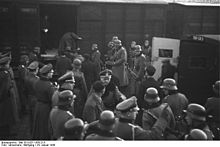- Ordnungspolizei
-
Not to be confused with Ordnungsamt, Ordnungspolizei of Hesse, Ordnungspolizei of the Rhineland-Palatinate, or Ordnungsbehörde.
Orpo Ordnungspolizei 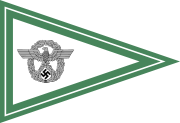
Ordnungspolizei commander pennant 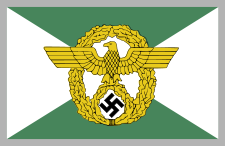
The Orpo was under the administration of the Interior Ministry but headed by members of the SS. 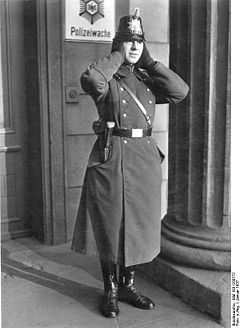
A uniformed German policeman in Berlin, January 1937. Agency overview Formed June 26, 1936 Superseding agency  Landespolizei (W.Germany)
Landespolizei (W.Germany)
 Volkspolizei (E.Germany)
Volkspolizei (E.Germany)Jurisdiction  Germany
Germany
Occupied EuropeHeadquarters Hauptamt Ordungspolizei, Prinz-Albrecht-Straße, Berlin
52°30′26″N 13°22′57″E / 52.50722°N 13.3825°EEmployees 401,300 (1944)[1] Ministers responsible Heinrich Himmler 1936–1945, Chief of German Police
Wilhelm Frick (nominally) 1936-1943, Reich Interior Minister
Heinrich Himmler 1943–1945, Reich Interior MinisterAgency executives SS-Oberstgruppenführer und Generaloberst der Polizei Kurt Daluege, Chief of the Ordnungspolizei, 1936–1943
SS-Obergruppenführer und General der Polizei und Waffen-SS Alfred Wünnenberg, Chief of the Ordnungspolizei, 1943–1945Parent agency Reichsinnenministerium (Reich Interior Ministry) The Ordnungspolizei or Orpo (English: Order Police) were the uniformed regular police force in Nazi Germany between 1936 and 1945. It was increasingly absorbed into the Nazi police system. Owing to their green uniforms, they were also referred to as Grüne Polizei (green police). The Orpo was established as a centralized organisation uniting the municipal, city, and rural uniformed forces that had been organised on a state-by-state basis. Eventually the Orpo embraced virtually all of the Third Reich's law-enforcement and emergency response organizations, including fire brigades, coast guard, civil defence, and even night watchmen.
Contents
History
On 17 June 1936, Reichsführer-SS Heinrich Himmler was named Chef der Deutschen Polizei im Reichsministerium des Innern (Chief of German Police in the Interior Ministry) after Hitler announced a decree that was to "unify the control of Police duties in the Reich".[2] Traditionally, law enforcement in Germany had been a state and local matter. In this role, Himmler was nominally subordinate to Interior Minister Wilhelm Frick. However, the decree effectively subordinated the police to the SS, making it virtually independent of Frick's control. Himmler gained authority as all of Germany's uniformed law enforcement agencies were amalgamated into the new Ordnungspolizei, whose main office became populated by officers of the SS.
The police were divided into the Ordnungspolizei (Orpo or regular police) and the Sicherheitspolizei (SiPo or security police), which had been established in June 1936.[3] The Orpo assumed duties of regular uniformed law enforcement while the SiPo consisted of the secret state police (Geheime Staatspolizei or Gestapo) and criminal investigation police (Kriminalpolizei or Kripo). The Kriminalpolizei was a corps of professional detectives involved in fighting crime and the task of the Gestapo was combating espionage and political dissent. On 27 September 1939, the SS security service, the Sicherheitsdienst (SD) and the SiPo were folded into the Reich Main Security Office (Reichssicherheitshauptamt or RSHA).[4] The RSHA symbolized the close connection between the SS (a party organization) and the police (a state organization).
Generalmajor der Ordnungspolizei und SS-Brigadefuhrer Wilhelm Fritz von Roettig was the first general to be killed in World War II, in Opoczno, Poland on 10 September 1939.
The Order Police played a central role in carrying out the Holocaust, as stated by Professor Browning: It is no longer seriously in question that members of the German Order Police, both career professionals and reservists, in both battalion formations and precinct service or Einzeldienst, were at the center of the Holocaust, providing a major manpower source for carrying out numerous deportations, ghetto-clearing operations, and massacres.[5]
Organization
 Orpo Chief Kurt Daluege in 1933, as a general in the Prussian Landespolizei.
Orpo Chief Kurt Daluege in 1933, as a general in the Prussian Landespolizei.
The Orpo was under the control of Reichsführer-SS Heinrich Himmler who was the Chef der Deutschen Polizei im Ministerium des Innern (Chief of the German Police in the Ministry of the Interior). It was initially commanded by SS-Oberstgruppenführer und Generaloberst der Polizei Kurt Daluege. But in 1943, Daluege had a massive heart attack and was removed from duty. He was replaced by SS-Obergruppenführer und General der Waffen-SS und der Polizei Alfred Wünnenberg, who served until the end of the war.
By 1941, the Orpo had been divided into the following offices covering every aspect of German law enforcement:
- Headquarters (Hauptamt Ordungspolizei) was the central command office of the entire Ordnungspolizei and from 1943 was considered a full SS-Headquarters command.
- Administration (Verwaltungspolizei) was the administrative branch of the Orpo and had overall command authority for all Orpo police stations. The Verwaltungspolizei also was the central office for record keeping and was the command authority for civilian law enforcement groups, which included the Gesundheitspolizei (health police), Gewerbepolizei (commercial or trade police), and the Baupolizei (building police). In the main towns, Verwaltungspolizei, Schutzpolizei and Kriminalpolizei would be organised into a police administration known as the Polizeipraesidium or Polizeidirektion, which had authority over these police forces in the urban district.
- Municipal police (Schutzpolizei; "protection police") served as Germany's municipal police force and was tasked with maintaining order in German cities and larger towns. The Schutzpolizei was further divided into the following:
- Schutzpolizei des Reiches (cities and large towns), which included police-station duties (Revierdienst) and barracked police units for riots and public safety (Kasernierte Polizei)
- Schutzpolizei der Gemeinden (smaller towns)
- Gendarmerie (rural police) were tasked with frontier law enforcement to include small communities, rural districts, and mountainous terrain. Members of the Gendarmerie were mainly employed to combat poaching and also as Alpine troops for homeland defense. With the development of a network of motorways or Autobahnen, motorized gendarmerie companies were set up in 1937 to secure the traffic.
- Traffic police (Verkehrspolizei) was the traffic-law enforcement agency and road safety administration of Germany. The organization patrolled Germany's roads (other than motorways which were controlled by Motorized Gendarmerie) and responded to major accidents. The Verkehrspolizei was also the primary escort service for high Nazi leaders who traveled great distances by automobile.
- Water police (Wasserschutzpolizei) was the equivalent of the coast guard and river police. Tasked with the safety and security of Germany's rivers, harbors, and inland waterways, the group also had authority over the SS-Hafensicherungstruppen ("harbour security troops") which were Allgemeine-SS units assigned as port security personnel.
- Railway police (Bahnschutzpolizei) was made up of part-time police officers who were also employees of the Reichsbahn (state railway). The Bahnschutzpolizei was tasked with railway safety and also preventing espionage and sabotage of railway property.
- Postal police (Postschutz) comprised roughly 4,500 members and was tasked with the security of Germany's Reichspost, which was responsible not only for the mail but other communications media such as the telephone and telegraph systems.
- Fire guards (Feuerschutzpolizei) consisted of all professional fire departments under a national command structure. The Orpo Hauptamt also had authority over the Freiwillige Feuerwehren, the local volunteer civilian fire brigades. At the height of the Second World War, in response to heavy bombing of Germany's cities, the combined Feuerschutzpolizei and Freiwillige Feuerwehren numbered nearly two million members.
- Air raid protection (Luftschutzpolizei) was the civil protection service in charge of air raid defence and rescue victims of bombings in connection with the Technische Nothilfe (Technical Emergency Service) and the Feuerschutzpolizei (Fire Brigades). Created as the Security and Assistance Service (Sicherheits und Hilfsdienst) in 1935, it was renamed Luftschutzpolizei in April 1942. The air raid network was supported by the Reichsluftschutzbund (Reich Association for Air Raid Precautions) an organization controlled from 1935 by the Air Ministry under Hermann Göring. The RLB set up an organization of air raid wardens who were responsible for the safety of a building or a group of houses.
- Technical Emergency Corps (Technische Nothilfe or TeNo) was a corps of engineers, technicians and specialists in construction work. TeNo was created in 1919 to keep the public utilities and essential industries running during the wave of strikes. From 1937 TeNo became a technical auxiliary corps of the police and was absorbed into Orpo Hauptamt. By 1943, the TeNo had over 100,000 members.
- Radio guard (Funkschutz) was made up of SS and Orpo security personnel assigned to protect German broadcasting stations from attack and sabotage. The Funkschutz was also the primary investigating service which detected illegal reception of foreign radio broadcasts.
- Factory protection (Werkschutzpolizei) were the night watchmen of the Third Reich. Its personnel were civilians who answered to a central Orpo office and typically were issued paramilitary uniforms, mostly surplus black or grey Allgemeine-SS jackets with Orpo insignia.
Police Battalions
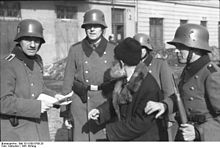 Ordnungspolizei conducting a raid (razzia) in the Krakow ghetto, January 1941.
Ordnungspolizei conducting a raid (razzia) in the Krakow ghetto, January 1941.
Between 1939 and 1945, the Ordnungspolizei also maintained separate military formations, independent of the main police offices within Germany. The first such formations were the Police Battalions (SS-Polizei-Bataillone), for various auxiliary duties outside of Germany, including anti-partisan operations, construction of defense works (i.e. Atlantic Wall), and support of combat troops.[6] Specific duties varied widely from unit to unit from one year to another.[7] Generally, the SS Polizei units were not directly involved in combat.[8] Some Police Battalions were primarily focused on traditional security roles of an occupying force while others were directly involved in the Holocaust. This latter role was obscured in the immediate aftermath of World War II, both by accident and by deliberate obfuscation, when most of the focus was on the better-known Einsatzgruppen ("Operational groups") who reported to the Reichssicherheitshauptamt (RSHA — Reich Main Security Office) under Reinhard Heydrich.[9]
The Police Battalions consisted of approximately 500 men armed with light infantry weapons. The battalions were originally numbered in series from 1 to 325, but in February 1943 were renamed and renumbered from 1 to about 37[6] to distinguish from Schutzmannschaft, auxiliary police battalions recruited from local population in German-occupied areas.[8] The Police Battalions were organizationally and administratively under Chief of Police Kurt Daluege but operationally they were under the authority of regional SS- und Polizeiführer (SS and Police Leaders), who reported up a separate chain of command, bypassing Daluege, directly to Reichsführer SS Heinrich Himmler.[10] While these units were similar to Waffen-SS divisions, they were not part of the Waffen-SS and should not be confused with the 4th SS Polizei Division.[6]
During the invasion of Poland in 1939, Police Battalions committed atrocities against both the Catholic and the Jewish populations[11] and as security forces patrolled the perimeters of the Jewish ghettos in Poland (SS, SD, and in some cases the Criminal Police were responsible for internal ghetto security issues in conjunction with Jewish ghetto administration[12]). Starting in 1941 Police Battalions and local Order Police units helped to transport Jews from the ghettos in both Poland and the USSR (and elsewhere in occupied Europe) to the concentration and extermination camps, as well as operations to hunt down and kill Jews outside the ghettos.[13]
Operating both independently and in conjunction with the Einsatzgruppen, Police Battalions were also an integral part of the "Final Solution" in Operation Barbarossa, the invasion of the Soviet Union which began on 22 July 1941. Police Battalions, whether as part of Police Regiments or as separate units or reporting directly to the local SS-und-Polizeiführer were part of the first and second waves of killing in 1941–2 in the USSR and also in killing operations in Poland.[14] Police Battalion involvement in direct killing operations are responsible for at least 1 million deaths.[15]
The Order Police were one of the two primary sources from which the Einsatzgruppen drew personnel in accordance with manpower needs (the other being the Waffen-SS).[16]
The majority of police battalions formed 28 Police Regiments as of 1942, many of which saw combat on the Eastern Front during the retreat of the German army.
The regular military police of the Wehrmacht (Feldgendarmerie) were separate from the Ordnungspolizei.
Waffen-SS Police Division
Main article: 4th SS Polizei DivisionThe primary military arm of the Ordnungspolizei was the SS Polizei Division, 4th Panzergrenadier Division of the Waffen-SS. Mainly used as a rear guard and reserve formation, the Polizei Division was historically known as being undertrained and lacking in skilled combat tactics. The division consisted of four police regiments composed of Orpo personnel and was typically used to rotate police members into a military situation, so as not to lose police personnel to the general draft of the Wehrmacht or to the full SS divisions of the regular Waffen-SS.
Very late in the war several Orpo SS-Police regiments were transferred to the Waffen-SS to form the 35th SS and Police Grenadier Division.
Orpo and SS Unity
The Ordnungspolizei was separate from the SS and maintained a system of insignia and Orpo ranks. It was possible for policemen to be members of the SS but without active duties. Police generals who were members of the SS were referred to simultaneously by both rank titles during the war. For instance, a Generalleutnant in the Police who was also an SS member would be referred to as SS Gruppenführer und Generalleutnant der Polizei. In addition, those Orpo police generals that undertook the duties of both Senior SS and Police Leader (Höhere SS und Polizeiführer) gained equivalent Waffen-SS ranks in August 1944 when Himmler was appointed Chef der Ersatzheeres (Chief of Home Army), because they had authority over the prisoner-of-war camps in their area.
Heinrich Himmler's ultimate aim was to replace the regular police forces of Germany with a combined racial/state protection corps (Staatsschutzkorps) of pure SS units. Local law enforcement would be undertaken by the Allgemeine-SS with the Waffen-SS providing homeland-security and political-police functions. Historical analysis of the Third Reich has revealed that senior Orpo personnel knew of Himmler's plan and were opposed to it.
Orpo legacy
At the close of the Second World War, the Orpo ceased to exist; but many of its personnel continued with business as usual, performing police services for the Allied occupation forces. The traditions of the Orpo continued in East Germany, which maintained a state police force (Volkspolizei) designed after the SS structures, being based on a centralized system. In West Germany, the police were decentralized again, as they had been before 1936, with each of the new federal states (called Bundesländer) establishing its own police force Landespolizei, each of which survives to this day. Many Landespolizei regulations, procedures, and even some uniforms, which are green, and insignia, can be traced back to the pre-1936 forces.
See also
Notes
- ^ Burkhardt Müller-Hillebrandt: Das Heer (1933-1945), Vol. III Der Zweifrontenkrieg, Mittler, Frankfurt am Main 1969, p. 322
- ^ Williams, Max. Reinhard Heydrich: The Biography: Volumes 1. 2001, p 77.
- ^ Williams, p 77.
- ^ Lumsden, Robin. A Collector's Guide To: The Allgemeine - SS, p 83.
- ^ Browning, Nazi Policy, at p 143.
- ^ a b c United States War Department (1995) [March 1945]. Handbook on German Military Forces. Louisiana State University Press. pp. 202–203. ISBN 0807120111. http://books.google.com/books?id=b3W1tiuHzcoC&pg=PA202.
- ^ Breitman, Richard, Official Secrets, Hill and Wang: NY, 1998, p 5 & Goldhagen, Daniel J., Hitler's Willing Executioners: Ordinary Germans and the Holocaust, Random House: USA, 1996, p 186.
- ^ a b Williamson, Gordon (2004). The SS: Hitler's Instrument of Terror. Zenith Imprint. p. 101. ISBN 0760319332. http://books.google.com/books?id=7gv7yPIdQdsC&pg=PA101.
- ^ Hillberg, Raul, The Destruction of the European Jews, Holmes & Meir: NY, NY, 1985, pp 100–106.
- ^ Hillberg, pp 71–73.
- ^ Rossino, Alexander B., Hitler Strikes Poland, University of Kansas Press: Lawrence, Kansas, 2003, pp 69–72, en passim
- ^ Hillberg, p 81.
- ^ Goldhagen, p 195.
- ^ Hillberg, pp 175, 192–198, en passim
- ^ Goldhagen, pp 202, 271–273, Goldhagen's citations include Israel Gutman, Encyclopedia of the Holocaust, NY: Macmillan 1990
- ^ Hillberg, pp 105–106.
References
- Browning, Christopher, Nazi Policy, Jewish Workers, German Killers, Cambridge University Press, 1999. ISBN 052177490X.
- Lumsden, Robin, A Collector's Guide To: The Allgemeine - SS, Ian Allan Publishing, Inc. 2001. ISBN 0-7110-2905-9.
- Williams, Max, Reinhard Heydrich: The Biography: Volume 1, Ulric Publishing, 2001. ISBN 0-9537577-5-7.
- Nix Philip and Jerome Georges The Uniformed Police Forces of the Third Reich 1933-1945, Leandoer & Ekholm, 2006. ISBN 91-975894-3-8
Further reading
- Browning, Christopher (1992). Ordinary Men: Reserve Police Battalion 101 and the Final Solution in Poland. New York: HarperCollins. ISBN 978-0060190132.
Heiner Lichtenstein: Himmlers grüne Helfer, Bund-Verlag Köln 1990, ISBN 3-7663-2100-5
External links
Einsatzgruppen Director Commanders and
higher authorities- Humbert Achamer-Pifrader
- Erich von dem Bach-Zelewski
- Rudolf Batz
- Ernst Biberstein
- Wolfgang Birkner
- Paul Blobel
- Friedrich-Wilhelm Bock
- Otto Bradfisch
- Werner Braune
- Fritz Dietrich
- Erich Ehrlinger
- Wilhelm Fuchs
- Karl Jäger
- Friedrich Jeckeln
- Heinz Jost
- Waldemar Klingelhöfer
- Wolfgang Kügler
- Rudolf Lange
- Erich Naumann
- Arthur Nebe
- Otto Ohlendorf
- Hans-Adolf Prützmann
- Otto Rasch
- Walter Rauff
- Martin Sandberger
- Eberhard Karl Schöngarth
- Franz Walter Stahlecker
- Eduard Strauch
- Bruno Streckenbach
- Martin Weiss
- Udo von Woyrsch
Members and others - August Becker
- Emil Haussmann
- Felix Landau
- Albert Widmann
Notable collaborators - Viktors Arājs
- Herberts Cukurs
- Konrāds Kalējs
Methods and
documentationInvolved
organizations- SS
- RSHA
- SD
- Orpo
- Arajs Kommando
- Estonian Auxiliary Police
- Latvian Auxiliary Police
- Lithuanian Security Police
- TDA
- 8th SS Cavalry Division Florian Geyer
- Rollkommando Hamann
- Schutzmannschaft
- Ukrainian Auxiliary Police
- Ypatingasis būrys
Crimes by country Poland- Operation Tannenberg
- Intelligenzaktion
- AB-Aktion
- Operation Reinhard
Lithuania- Ninth Fort
- Kaunas June 1941
- Kaunas 29 October 1941
- Ninth Fort November 1941
- Ponary
Latvia- Burning of the Riga synagogues
- Dünamünde Action
- Jelgava
- Pogulianski
- Rumbula
- Liepāja (Šķēde)
EstoniaBelarus- Łachwa Ghetto
- Minsk Ghetto
- Sluzk Affair
UkraineCategories:- Nazi SS
- Defunct law enforcement agencies of Germany
- German words and phrases
- Holocaust terminology
Wikimedia Foundation. 2010.

